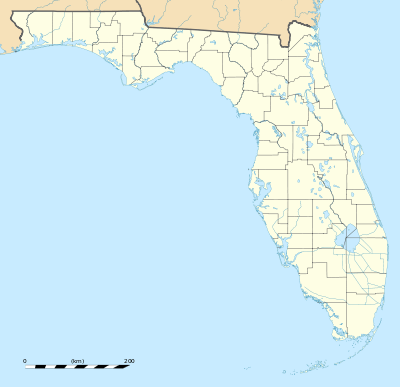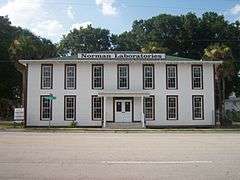Norman Studios
 | |
| Established | 1920 |
|---|---|
| Location | Jacksonville, Florida, United States |
| Type | Film |
| Website | |
|
Norman Film Studios | |
|
Restored facility in Jacksonville | |
  | |
| Location | Jacksonville, Florida |
| Coordinates | 30°20′01″N 81°35′37″W / 30.33361°N 81.59361°WCoordinates: 30°20′01″N 81°35′37″W / 30.33361°N 81.59361°W |
| NRHP Reference # | 14001084,[1] 16000857 |
| Significant dates | |
| Added to NRHP | December 29, 2014 |
| Designated NHL | October 31, 2016[2] |
Norman Studios was an American film studio in Jacksonville, Florida. Founded by Richard Edward Norman, the studio produced silent films featuring all-African-American casts from 1920 to 1928. The only surviving studio from the period of early filmmaking in Jacksonville, its facilities are now the Norman Studios Silent Film Museum.
One of the most prominent studios creating films for black audiences in the silent era, Norman's films featured all-black casts with protagonists in positive roles. During its run it produced eight feature length films and numerous shorts; its only surviving film, The Flying Ace, has been restored by the Library of Congress. The studio transitioned to distribution and promotion after the rise of talking pictures made its technology obsolete, and eventually closed. In the 21st century, the studio's facilities were restored and re-purposed as a museum.
On October 31, 2016, the location was designated a National Historic Landmark.[2]
History
Early history
During the early 20th century, the emerging film industry that was traditionally located in New York built a new home in Northeast Florida so they could continue filming during the winter. Jacksonville, home to over thirty silent film studios from 1908 – 1922, became known as the “Winter Film Capital of the World”.[3] Eagle Film Studios, which would later become Norman Studios, was built in 1916.[4] The five buildings composing the studio would go bankrupt in the following years.
Richard Norman

Born in Middleburg, Florida in 1891,[4] Richard Edward Norman started his career in the Midwest by making movies for white audiences in the 1910s. He filmed events or people acting out skits and screened these films at the local theatre, church, or school. His first silent film with an all black cast was The Green-Eyed Monster (1919), set in the railroad industry. This was an updated take on an earlier silent film called The Wrecker, a popular action/adventure film with an all-white cast.[5] Norman moved to Jacksonville during the height of the film industry and bought the studio in 1920 at the age of 29. It may be that Norman occupied the studios before purchasing them[6] The success of the film brought attention to the studio from other African-American actors hoping to star in later films.
Race films
During the time, films with an African-American cast and shown specifically to African-American audiences were known as race films. Norman Studios produced several of these films during the 1920s. Richard Norman’s reason to produce race films was not solely a business decision as some would believe.[7] Although the studio was indeed filling a niche, Norman was also motivated by the state of race relations at the time.[8] The untapped black filmgoer market and the plethora of talented performers unable to get work in mainstream films lead to the production of race films by Norman Studios.
Later films produced by Norman Studios include The Love Bug (1919); The Bull-Dogger (1921), a western; The Crimson Skull (1922), another western; Regeneration (1923), an action adventure set on an island after a shipwreck; The Flying Ace (1926), Norman’s most famous film; and Black Gold (1928), a drama set around the oil business.
The Flying Ace

The only film from Norman Studios to be restored and kept in the Library of Congress, The Flying Ace was dubbed “the greatest airplane thriller ever filmed.”[4] It was filmed entirely on the ground, but used camera tricks to imply movement and altitude for the stationary airplanes. The film was inspired by aviators like Bessie Coleman who sent a letter to Norman Studios expressing a wish to create a film based on her life.[9]
The plot of the film revolves around a former World War I fighter pilot returning home to his previous job of a railroad company detective. Once back, he has to solve a case involving stolen money and a missing employee in order to catch the thieves. The film is the only one from the period known to have survived.[10] The Library of Congress keeps a copy of the film as it is deemed culturally significant.[7] Nowadays, The Flying Ace is screened occasionally across the nation.[11]
Decline
Norman Studios’ run as a producer of race films came to a close due to a couple of factors. One such factor was the advent of talking films. Richard Norman invested and developed a system to sync audio to the moving images. Units were sold to theaters in the nation, but unfortunately a new method of putting sound-on-film debuted making Norman’s system obsolete.[12]
Filmmakers were already steadily making an exodus to southern California which emerged as a new hub for films. In 1917, John W. Martin was elected mayor of Jacksonville on an anti-film campaign intending to curb the wild excesses of the film industry.[13] Filmmakers did not help their cause by filming car chases on the streets on Sundays, pulling alarms to film fire trucks, or accidentally inciting riots.[14] By the 1930s, the film industry had moved on from Jacksonville while Norman Studios became a distributor of films and then Richard Norman began exhibiting films in the 1940s.[15]
Gloria Norman School of Dance
Gloria Norman, the wife of Richard Norman, began teaching dance in 1935 on the second floor of the main production and film printing building.[12] Richard, who was still in the film business by producing industrial films for the Pure Oil Co. and distributing Joe Louis fight films, felt the sounds of dancing were too loud. A dance floor was built in the set building which is now used as the site for the Circle of Faith Ministries and is the sole building of the original five not owned by Jacksonville currently.[4]
After Gloria sold the studio in 1976,[15] the building became the location for a variety of companies such as plumbing and telephone answering services.[7]
Revitalization
Rediscovery
Only when Ann Burt, a local resident, discovered that the dilapidated buildings were actually an important movie studio in another time were there efforts to make the former site of Norman Studios into a museum. As a member of the Old Arlington Inc, an Arlington area preservationist group, Burt was able to bring together others to save the site.[15]
Norman Studios Silent Film Museum
Three years after the movement began,[16] the city of Jacksonville bought four of the original five buildings for $260,000 in April 2002.[7] The structures acquired were the main production and processing building, a small cottage for costume changes, a storage shed, and a building that holds the original power generators for the cameras and lights. It was not until February 2004 that the city received a grant from the state of Florida to help preserve and restore the aging complex.[16] Their $140,000 grant was used for emergency roofing, security lighting, a security system, and the largest chunk was paid to Kenneth Smith Architects to redesign the complex into its future life as the Norman Studios Silent Film Museum.[17]
Restoration of the exterior of the property completed in about 2008,[17] while more fundraising has been done to try to purchase the fifth building from the Circle of Faith Ministries.
Currently, Jacksonville is beginning the process to transfer the Norman Studios Silent Film Museum to the National Park Service. The move will allow the federal government to pay for the preservation and restoration of the studio as well as the operation of the buildings.[10] Transferring the buildings to the National Park Service will help refurbish the interior of the buildings which the city and the museum group have been unable to afford.
The successful National Historic Landmark nomination was written as part of a graduate-level course at the University of Central Florida.[18]
Board of Directors
- Capt. Richard E. & Kathy Norman
- Devan Stuart, Board Chair, Media & Publicity Director
- Anthony Hodge, Board Co-Chair, Webmaster
- Rita Reagan, Historian, Community & Education Outreach Director
- Patricia Hodge, Treasurer
- Laura Lavernia, Secretary
- Emily Rose, Corporate Outreach Director
- Cher Davis, Web Designer/Social Media Strategist, Communications Committee
- Nicholas Clancy
- Amy Lynn Calfee
- Erminda Flores
- Meredith Tano
- Chris Lesley
List of films
- Sleepy Sam, the Sleuth (1915)
- The Love Bug (1919)
- The Green-Eyed Monster (1919)
- The Bull-Dogger (1921)
- The Crimson Skull (1922)
- Regeneration (1923)
- The Flying Ace (1926)
- Black Gold (1928)
References
- ↑ "Norman Film Studios". National Park Service. Retrieved 2015-11-03.
- 1 2 "Secretary Jewell, Director Jarvis Announce 10 New National Historic Landmarks Illustrating America's Diverse History, Culture". Department of the Interior. November 2, 2016. Retrieved 3 November 2016.
- ↑ "Norman Film Studios". Jacksonville's Legacy. 1: 20–21. September 2013. Retrieved 3 November 2016.
- 1 2 3 4 "The Past « Norman Studios – Preserving the legacy of silent film in Northeast Florida". Normanstudios.org. Retrieved 2014-01-14.
- ↑ Lupeck, 2016 p. 124
- ↑ Bowser (2001), p. 316
- 1 2 3 4 "Comeback role in works for an old movie legend". Jacksonville.com. 2002-05-20. Retrieved 2014-01-14.
- ↑ McCarthy (2007), p. 63
- ↑ Hart (1996), p. 62
- 1 2 "Jacksonville prepares to transfer historic Norman Studio to federal park system | members.jacksonville.com". Jacksonville.com. Retrieved 2014-01-14.
- ↑ graphicstation (2011-05-13). "Progress Report « Norman Studios – Preserving the legacy of silent film in Northeast Florida". Normanstudios.org. Retrieved 2014-01-14.
- 1 2 Archived July 27, 2011, at the Wayback Machine.
- ↑ "Why the city never got a Hard Rock 06/14/98". Florida Times Union. Retrieved 2012-05-10.
- ↑ Word, Ron (2008-09-05). "Before There Was Hollywood - There Was Fla.'s Own Jacksonville". TheLedger.com. Retrieved 2014-01-14.
- 1 2 3 Clarke (2002) Gainesville Sun
- 1 2 "City lands grant for studio restoration". Bizjournals.com. Retrieved 2004-02-19.
- 1 2 Bean (2008), p. 156
- ↑ "Executive Summary Form, Norman Film Manufacturing Company, Jacksonville, FL" (PDF). National Historic Landmarks Program. National Park Service. Retrieved 3 November 2016.
- Sources
- Bean, Shawn C. The First Hollywood: Florida and the Golden Age of Silent Filmmaking. Gainesville: University of Florida, 2008. ISBN 0-8130-3243-1
- Bowser, Pearl, Jane Gaines, and Charles Musser. Oscar Micheaux and His Circle: African-American Filmmaking and Race Cinema of the Silent Era. Bloomington: Indiana UP, 2001. ISBN 0-253-33994-4
- Clarke, Ken. "Silent-film Studios May Soon Be Rescued." Gainesville Sun 22 Sept. 2002. Print.
- Hart, Philip S. Up in the Air: the Story of Bessie Coleman. Minneapolis: Carolrhoda, 1996. ISBN 0-87614-978-6
- McCarthy, Kevin. African American Sites in Florida. Sarasota, FL: Pineapple, 2007. ISBN 1-56164-385-8
- Lupack, Barbara Tepa. Early Race Filmmaking in America. New York: Routledge, 2016.
External links
- Official website
- Norman Studios at the Internet Movie Database
- Richard E. Norman Collection at Indiana University Bloomington Black Film Center/Archive
